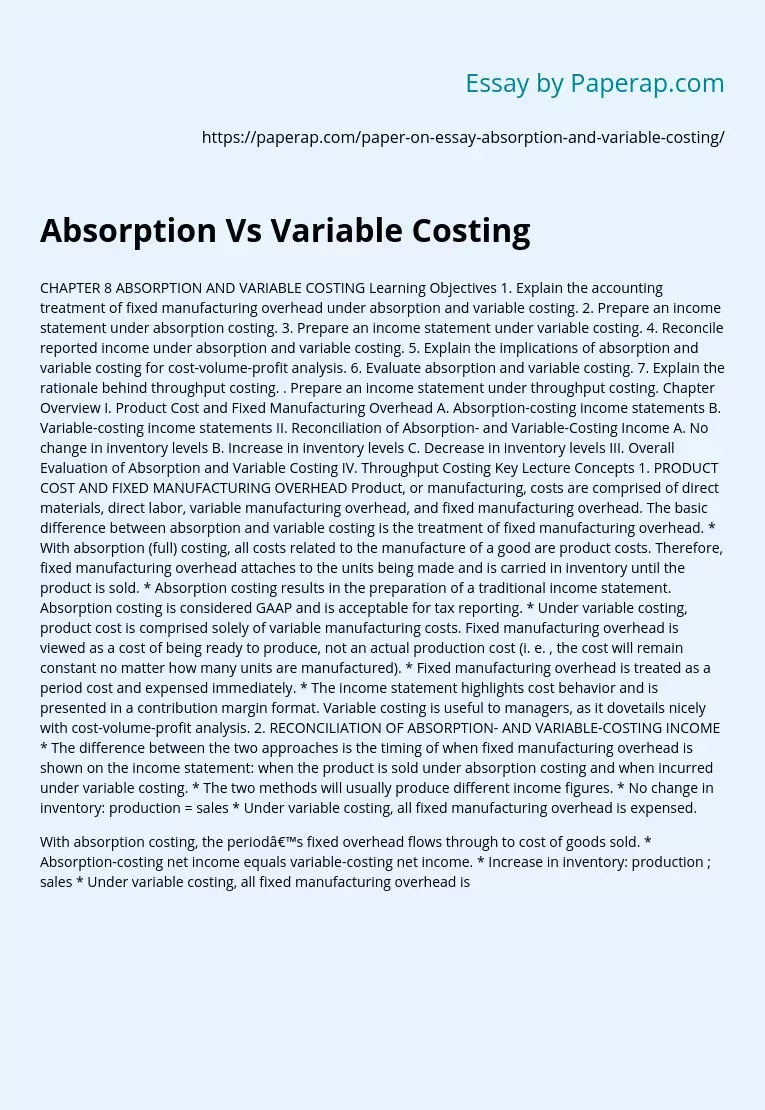Absorption Vs Variable Costing
CHAPTER 8 ABSORPTION AND VARIABLE COSTING Learning Objectives 1. Explain the accounting treatment of fixed manufacturing overhead under absorption and variable costing. 2. Prepare an income statement under absorption costing. 3. Prepare an income statement under variable costing. 4. Reconcile reported income under absorption and variable costing. 5. Explain the implications of absorption and variable costing for cost-volume-profit analysis. 6. Evaluate absorption and variable costing. 7. Explain the rationale behind throughput costing. . Prepare an income statement under throughput costing. Chapter Overview I. Product Cost and Fixed Manufacturing Overhead A.
Absorption-costing income statements B. Variable-costing income statements II. Reconciliation of Absorption- and Variable-Costing Income A. No change in inventory levels B. Increase in inventory levels C. Decrease in inventory levels III. Overall Evaluation of Absorption and Variable Costing IV. Throughput Costing Key Lecture Concepts 1. PRODUCT COST AND FIXED MANUFACTURING OVERHEAD Product, or manufacturing, costs are comprised of direct materials, direct labor, variable manufacturing overhead, and fixed manufacturing overhead.
The basic difference between absorption and variable costing is the treatment of fixed manufacturing overhead. * With absorption (full) costing, all costs related to the manufacture of a good are product costs. Therefore, fixed manufacturing overhead attaches to the units being made and is carried in inventory until the product is sold. * Absorption costing results in the preparation of a traditional income statement. Absorption costing is considered GAAP and is acceptable for tax reporting. * Under variable costing, product cost is comprised solely of variable manufacturing costs. Fixed manufacturing overhead is viewed as a cost of being ready to produce, not an actual production cost (i.
e. , the cost will remain constant no matter how many units are manufactured). * Fixed manufacturing overhead is treated as a period cost and expensed immediately. * The income statement highlights cost behavior and is presented in a contribution margin format. Variable costing is useful to managers, as it dovetails nicely with cost-volume-profit analysis. 2. RECONCILIATION OF ABSORPTION- AND VARIABLE-COSTING INCOME * The difference between the two approaches is the timing of when fixed manufacturing overhead is shown on the income statement: when the product is sold under absorption costing and when incurred under variable costing. * The two methods will usually produce different income figures. * No change in inventory: production = sales * Under variable costing, all fixed manufacturing overhead is expensed.
With absorption costing, the period’s fixed overhead flows through to cost of goods sold. * Absorption-costing net income equals variable-costing net income. * Increase in inventory: production ; sales * Under variable costing, all fixed manufacturing overhead is expensed. With absorption costing, a portion of the period’s fixed overhead flows through to cost of goods sold and a portion remains on the balance sheet in inventory. * Absorption-costing net income is greater than variable-costing net income. * Decrease in inventory: sales > production Under variable costing, all fixed manufacturing overhead is expensed. With absorption costing, as units manufactured in a prior period are sold, an amount greater than the current period’s fixed overhead flows through to cost of goods sold. * Absorption-costing net income is less than variable-costing net income. * The difference between absorption- and variable-costing income figures can be reconciled as follows: Income difference = Inventory change in units x Fixed overhead per unit The difference is likely to be very small over a lengthy time period. . OVERALL EVALUATION OF ABSORPTION AND VARIABLE COSTING * Pricing decisions * Absorption-cost proponents argue that fixed manufacturing overhead is a necessary production cost. Excluding this element from the inventoried cost of a product will understate the good’s cost, which is troublesome for companies that use cost-based pricing techniques. * Variable-cost proponents argue that variable cost is better for pricing decisions. Any price above a good’s variable cost results in a positive contribution margin for the company. Many firms use variable costing for internal-reporting purposes. Given that absorption costing must be employed for external financial reporting, companies can use both methods by making several simple end-of-period adjustments. 1 If a company operates in a just-in-time environment, inventories are kept very low and there will be little change in inventory from period to period. Thus, the income differences between absorption and variable costing will normally be insignificant. 4. THROUGHPUT COSTING Throughput costing assigns only the unit-level spending for direct costs as the cost of products or services. * A unit-level cost is incurred every time that a unit of product is manufactured. * All costs other than the throughput cost are considered to be operating expenses of the period. * Proponents of throughput costing argue that this procedure eliminates the incentive to produce excess inventory because all non-throughput costs are expensed regardless of manufacturing volume.
When Using Variable Costing Fixed Manufacturing Overhead Is
Absorption Vs Variable Costing. (2019, Dec 05). Retrieved from https://paperap.com/paper-on-essay-absorption-and-variable-costing/

